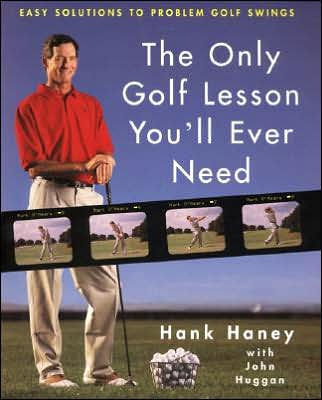The Only Golf Lesson You'll Ever Need, Hank Haney, one of the most respected and soughtafter golf instructors in the world, shares the secrets he's learned by observing hundreds of thousands of students—from top PGA Tour pros to high-handicappers. He explains how intelligent observation of your ball-flight tendencies—the way your shot behaves in the air—provides the answers to helping you develop a consistent repeating swing that will lower your scores. You'll also pick up valuable pointers on how to precisely match your equipment to your game.
Hank Haney believes that a "flawed swing" that still produces a good shot is a good swing. By focusing on the outcome of your swing first, rather than on the swing itself, he believes you can often avoid making the awkward and unnatural changes to grip, stance, posture and alignment that many golf instructors ask of their students.
The Only Golf Lesson You'll Ever Need will help you straighten your hook or slice, add distance to your drives, identify and fix the flaws in your swing, and become a wizard around the greens.
"I'm proud of the way my swing holds up ion all kinds of conditions and under the severest pressure. Both are a tribute to Hank Haney and his teaching. Hank knows more about ballflight and what controls it than anyone in the game. And if you understand that, you're on your way."
— Mark O'Meara from the Foreword to The Only Golf Lesson You'll Ever Need
The Only Golf Lesson You'll Ever Need, Hank Haney, one of the most respected and soughtafter golf instructors in the world, shares the secrets he's learned by observing hundreds of thousands of students—from top PGA Tour pros to high-handicappers. He explains how intelligent observation of your ball-flight tendencies—the way your shot behaves in the air—provides the answers to helping you develop a consistent repeating swing that will lower your scores. You'll also pick up valuable pointers on how to precisely match your equipment to your game.
Hank Haney believes that a "flawed swing" that still produces a good shot is a good swing. By focusing on the outcome of your swing first, rather than on the swing itself, he believes you can often avoid making the awkward and unnatural changes to grip, stance, posture and alignment that many golf instructors ask of their students.
The Only Golf Lesson You'll Ever Need will help you straighten your hook or slice, add distance to your drives, identify and fix the flaws in your swing, and become a wizard around the greens.
"I'm proud of the way my swing holds up ion all kinds of conditions and under the severest pressure. Both are a tribute to Hank Haney and his teaching. Hank knows more about ballflight and what controls it than anyone in the game. And if you understand that, you're on your way."
— Mark O'Meara from the Foreword to The Only Golf Lesson You'll Ever Need

Only Golf Lesson You'll Ever Need: Hank Haney's Proven Method for Analyzing and Diagnosing Problem Golf Swings
224
Only Golf Lesson You'll Ever Need: Hank Haney's Proven Method for Analyzing and Diagnosing Problem Golf Swings
224
Product Details
| ISBN-13: | 9780062702371 |
|---|---|
| Publisher: | HarperCollins Publishers |
| Publication date: | 04/28/1999 |
| Pages: | 224 |
| Sales rank: | 208,801 |
| Product dimensions: | 7.37(w) x 9.12(h) x 0.82(d) |
